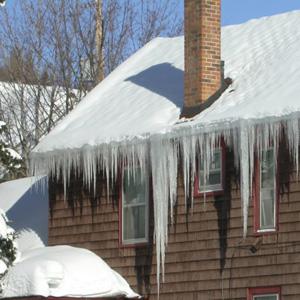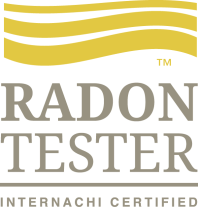Ice Dams
An ice dam is a ridge of ice that forms at the edge of a roof and prevents melting snow from draining. As water backs up behind the dam, it can leak through the roof and cause damage to walls, ceilings, insulation and other areas.
 How do ice dams form?
How do ice dams form?
Ice dams are formed by an interaction between snow cover, outside temperatures, and heat lost through the roof. Specifically, there must be snow on the roof, warm portions of the upper roof (warmer than 32° F), and cold portions of the lower roof (at freezing or below). Melted snow from the warmer areas will refreeze when it flows down to the colder portions, forming an ice dam.
Although the primary contributor to snow melting is heat loss from the building’s interior, solar radiation can also provide sufficient heat to melt snow on a roof. For example, in southern Canada, enough sunlight can be transmitted through 6 inches (150 mm) of snow cover on a clear and sunny day to cause melting at the roof’s surface even when the outside temperature is 14° F (-10° C), with an attic temperature of 23° F (-5° C).
Gutters do not cause ice dams to form, contrary to popular belief. Gutters do, however, help concentrate ice from the dam in a vulnerable area, where parts of the house can peel away under the weight of the ice and come crashing to the ground.
Problems Associated with Ice Dams
Ice dams are problematic because they force water to leak from the roof into the building envelope. This may lead to:
- rotted roof decking, exterior and interior walls, and framing;
- respiratory illnesses (allergies, asthma, etc.) caused by mold growth;
- reduced effectiveness of insulation. Wet insulation doesn’t work well, and chronically wet insulation will not decompress even when it dries. Without working insulation, even more heat will escape to the roof where more snow will melt, causing more ice dams which, in turn, will lead to leaks; and
- peeling paint. Water from the leak will infiltrate wall cavities and cause paint to peel and blister. This may happen long after the ice dam has melted and thus not appear directly related to the ice dam.
Prevention
- Keep the entire roof cold. This can be accomplished by implementing the following measures:
- Install a metal roof. Ice formations may occur on metal roofs, but the design of the roof will not allow the melting water to penetrate the roof’s surface. Also, snow and ice are more likely to slide off of a smooth, metal surface than asphalt shingles.
- Seal all air leaks in the attic floor, such as those surrounding wire and plumbing penetrations, attic hatches, and ceiling light fixtures leading to the attic from the living space below.
- Increase the thickness of insulation on the attic floor, ductwork, and chimneys that pass through the attic.
- Move or elevate exhaust systems that terminate just above the roof, where they are likely to melt snow.
- A minimum of 3″ air space is recommended between the top of insulation and roof sheathing in sloped ceilings.
- Remove snow from the roof. This can be accomplished safely using a roof rake from the ground. Be careful not to harm roofing materials or to dislodge dangerous icicles.
- Create channels in the ice by hosing it with warm water. Because this process intentionally adds water to the roof, this should be done only in emergencies where a great deal of water is already flowing through the roof, and when temperatures are warm enough that the hose water can drain before it freezes.
Prevention and Removal Methods to Avoid
- electric heat cables. These rarely work, they require effort to install, they use electricity, and they can make shingles brittle.
- manual removal of the ice dam using shovels, hammers, ice picks, rakes, or whatever destructive items can be found in the shed. The roof can be easily damaged by these efforts, as can the homeowner, when they slip off of the icy roof.
In summary, ice dams are caused by inadequate attic insulation, but homeowners can take certain preventative measures to ensure that they are rare.













